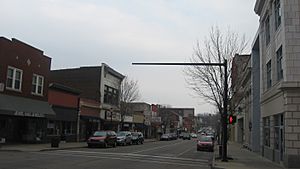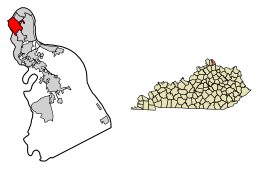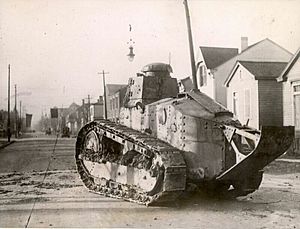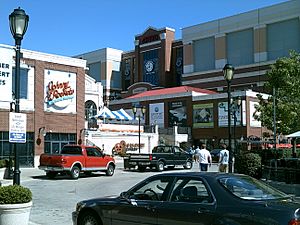Newport, Kentucky facts for kids
Quick facts for kids
Newport, Kentucky
|
|
|---|---|

Monmouth Street Historic District
|
|

Location of Newport in Campbell County, Kentucky.
|
|
| Country | United States |
| State | Kentucky |
| County | Campbell |
| Named for | Christopher Newport |
| Government | |
| • Type | Commission-City Manager |
| Area | |
| • Total | 3.01 sq mi (7.80 km2) |
| • Land | 2.75 sq mi (7.14 km2) |
| • Water | 0.26 sq mi (0.66 km2) |
| Elevation | 528 ft (161 m) |
| Population
(2020)
|
|
| • Total | 14,150 |
| • Estimate
(2022)
|
13,901 |
| • Density | 5,136.12/sq mi (1,982.99/km2) |
| Time zone | UTC-5 (Eastern (EST)) |
| • Summer (DST) | UTC-4 (EDT) |
| ZIP code |
41071-41072
|
| Area code(s) | 859 |
| FIPS code | 21-55884 |
| GNIS feature ID | 2404373 |
Newport is a city in Kentucky, located where the Ohio and Licking rivers meet. It's part of Campbell County, Kentucky, and had about 14,150 people in 2020. Newport is an important city in Northern Kentucky and is part of the larger Cincinnati metropolitan area.
Contents
Newport's History
Newport was started around 1791 by James Taylor Jr.. It was named after Christopher Newport, who was the commander of the first ship to reach Jamestown, Virginia, in 1607. Newport officially became a town on December 14, 1795, and then a city on February 24, 1834.
In 1803, a military post called Newport Barracks was set up here. The first bridge connecting Newport to Covington was built in 1853. Later, in 1866, the John A. Roebling Suspension Bridge opened, linking Newport to Cincinnati across the Ohio River. Many people from Germany moved to Newport in the late 1800s. By 1900, Newport was the third largest city in Kentucky.
Changes Over Time
During the Prohibition Era (when alcohol was illegal), Newport became known for its lively entertainment scene. Many places offered fun activities, and the city had a reputation for being a place where people could enjoy themselves.
In 1921, a big steel mill strike happened in Newport. Over 2,000 workers were involved. The strike lasted for seven years, ending in 1928. During this time, state military tanks were even brought into the town.
Newport faced a major natural disaster in 1937 when a large flood covered much of the city. To prevent future floods, a flood wall was built in 1948, which is still a key part of the city today.
Over the years, Newport's main street, Monmouth Street, was famous for its entertainment spots. However, the city decided to change its focus. In the 1980s and 1990s, Newport began to develop its riverfront to attract "family friendly" tourism. This led to the opening of the Newport Aquarium in 1999 and the Newport on the Levee entertainment complex in 2000.
In 1981, a garage making illegal fireworks exploded, causing a lot of damage in the area.
A very tall building called the "Millennium Tower" was planned in 1997. It was supposed to be 1,015 feet tall and finished by 2003. However, the project didn't happen because investors pulled out. Today, the spot where it was planned is a parking lot next to the World Peace Bell. In the 21st century, Newport has continued to grow as a center for entertainment.
Important Dates in Newport's History
- 1791 - Settlement laid out.
- 1795 - Town of Newport incorporated.
- 1796 - Campbell County Courthouse built.
- 1798 - Newport Academy founded.
- 1800 - Population: 106.
- 1804 - Newport Barracks established.
- 1812 - James Taylor mansion built.
- 1821 - Southgate house built (approximate date).
- 1831 - Taylor Methodist Episcopal Church built.
- 1834 - City of Newport chartered.
- 1836 - Newport Lyceum founded.
- 1844 - Silk factory begins operating.
- 1847 - Public school begins operating.
- 1850 - Washington Fire Engine and Hose Company (volunteer firefighters) established.
- 1859 - October 28: "Mob destroys the plant of the True South, abolition paper."
- 1860
- Public high school begins operating.
- Population: 10,046.
- 1866 - John A. Roebling Suspension Bridge opens near Newport.
- 1869 - John Butcher Brewery (later Wiedemann) in business.
- 1870 - Population: 15,087.
- 1871 - St. Paul's Episcopal Church built.
- 1872 - Newport and Cincinnati Bridge opens.
- 1873 - Southgate St. School established.
- 1880 – Population: 20,433.
- 1883 - Ohio River flood.
- 1884
- Ohio River flood.
- Campbell County Courthouse rebuilt.
- 1888 - U.S. military Fort Thomas established near Newport.
- 1890 - Cincinnati–Newport Bridge opens.
- 1891
- Andrews Steel Mill in business.
- George Ahlering elected mayor.
- 1898 - Ohio River flood.
- 1900 - Population: 28,301.
- 1902 - Carnegie Free Library opens.
- 1910 - Population: 30,309.
- 1913 - Ohio River flood.
- 1921 - Newport Steel worker labor strike begins.
- 1924 - Cote Brilliante becomes part of Newport.
- 1927 - Newport Finance Building constructed.
- 1928 - Newport steel strike officially ends, after 7 years.
- 1930 - City-manager form of government adopted.
- 1935 - Clifton becomes part of Newport.
- 1936 - Ingalls Park becomes part of Newport.
- 1937 - Flood.
- 1948 - Floodwall built.
- 1955 – The all-boys Newport Catholic High School opens a new campus on Carothers Road. The facility remains in use today by its coeducational successor, Newport Central Catholic High School.
- 1956 - Newport Shopping Center in business.
- 1961
- Anti-corruption "Committee of 500" formed.
- George Ratterman becomes county sheriff.
- 1973 - Regional Transit Authority of Northern Kentucky (public transit) established.
- 1975 - Newport News begins publication.
- 1976 - Daniel Carter Beard Bridge opens.
- 1978 - Campbell County Public Library established.
- 1980
- Irene Deaton becomes first female mayor of Newport.
- Mansion Hill designated an historic district.
- 1983
- Steve Goetz elected mayor.
- Newport Central Catholic High School is created by the merger of the all-boys Newport Catholic High School and all-girls Our Lady of Providence Academy.
- 1990 - Campbell County Historical Society founded.
- 1992 - Tom Guidugli becomes mayor.
- 1995 - Taylor–Southgate Bridge opens.
- 1999 - Newport Aquarium opens.
- 2000 - Population: 17,048.
- 2001 - Newport on the Levee "entertainment complex" in business.
- 2004 - L&N Bridge pedestrianized.
- 2005 - Geoff Davis becomes U.S. representative for Kentucky's 4th congressional district.
- 2008 - Jerry Peluso elected mayor.
- 2010 - Population: 15,273.
- 2012 - Thomas Massie becomes U.S. representative for Kentucky's 4th congressional district.
- 2021 - Thomas Guidugli, Jr elected mayor
Newport as a County Seat
Newport is one of the county seats for Campbell County. A county seat is the main town where the county government offices are located. Newport has been a county seat at different times in history.
In the 1800s, most people lived in Newport and nearby cities. They found it hard to travel to Alexandria, which was also a county seat, because it was further south and less developed. So, in 1883, Newport worked to get a special law passed. This law allowed an additional courthouse to be built in Newport, so county business could be done in both Newport and Alexandria.

There have been legal discussions about whether Newport is truly an equal county seat. In 2009, a court said Alexandria was the only one. But in 2010, another court said Newport had equal status. The highest court in Kentucky decided not to review this decision in 2011, meaning Newport keeps its equal status.
Newport's Geography and Climate
Newport covers about 3 square miles. Most of this area is land, but about 0.2 square miles is water. The city is located where the Bluegrass region meets the Midwest. So, you can describe Newport as being in either of these areas.
Newport's climate is a mix of different weather patterns. It's close to the northern edge of the humid subtropical climate, which means it can have warm, humid summers.
Newport's Population
| Historical population | |||
|---|---|---|---|
| Census | Pop. | %± | |
| 1800 | 106 | — | |
| 1810 | 413 | 289.6% | |
| 1830 | 715 | — | |
| 1850 | 5,895 | — | |
| 1860 | 10,046 | 70.4% | |
| 1870 | 15,087 | 50.2% | |
| 1880 | 20,433 | 35.4% | |
| 1890 | 24,918 | 21.9% | |
| 1900 | 28,301 | 13.6% | |
| 1910 | 30,309 | 7.1% | |
| 1920 | 29,317 | −3.3% | |
| 1930 | 29,744 | 1.5% | |
| 1940 | 30,631 | 3.0% | |
| 1950 | 31,044 | 1.3% | |
| 1960 | 30,070 | −3.1% | |
| 1970 | 25,998 | −13.5% | |
| 1980 | 21,587 | −17.0% | |
| 1990 | 18,871 | −12.6% | |
| 2000 | 17,048 | −9.7% | |
| 2010 | 15,273 | −10.4% | |
| 2020 | 14,150 | −7.4% | |
| 2022 (est.) | 13,901 | −9.0% | |
| U.S. Decennial Census | |||
As of 2020, about 14,150 people lived in Newport. The city has a population density of about 5,136 people per square mile. Most of the people living in Newport are White (79.7%), followed by Black or African American (9.1%). About 5.7% of the population is Hispanic or Latino.
The average age of people in Newport is about 38.4 years old. About 15.4% of the population is under 18, and 15.2% is 65 or older. The average household size is 1.98 people. The estimated average yearly income for a household in Newport was about $44,095 between 2016 and 2020.
Newport's Economy
Newport is known for Newport on the Levee, a popular place for dining and entertainment. This complex is home to the Newport Aquarium, which is a big attraction for visitors.
Education in Newport
Newport's public schools are part of the Newport Independent Schools School District. The district includes an elementary school, an intermediate school, a middle school, and a high school.
Newport also has a private Catholic high school called Newport Central Catholic. This school has been open for over 100 years. The city also has a public library, which is a branch of the Campbell County Public Library.
Newport in Media
Newport has been a filming location for several movies. A famous scene from the 1988 movie Rain Man, where the character Raymond counts toothpicks, was filmed at Pompilio's Italian restaurant in Newport.
Parts of the 2019 Netflix movie Extremely Wicked, Shockingly Evil and Vile were also filmed in Newport. These scenes showed parts of Monmouth Street, the Pepper Pod restaurant, and Newport's historic courthouse. A scene from the 2011 movie The Ides of March was also shot here.
The Fox TV channel for the Cincinnati area, WXIX-TV (channel 19), is officially licensed to Newport. However, its main operations and broadcast tower are actually across the river in Ohio.
Notable People from Newport
- John Alexander, an actor known for playing Teddy Brewster in Arsenic and Old Lace.
- Dave Cowens, a famous NBA basketball player and member of the Basketball Hall of Fame.
- Brent Spence, a Democratic Congressman and lawyer from Northern Kentucky. The Brent Spence Bridge is named after him.
See also
 In Spanish: Newport (Kentucky) para niños
In Spanish: Newport (Kentucky) para niños




